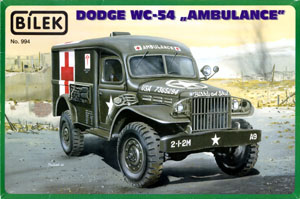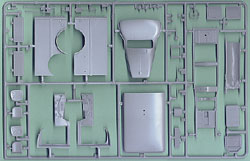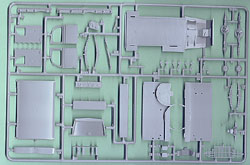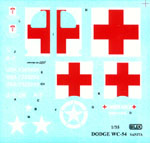


 Bilek's
1/35th Dodge
Bilek's
1/35th Dodge
WC-54 Ambulance
By Ray Mehlberger
History
The Dodge WC-54 was the standard field ambulance during WWII. These vehicles were manufactured by Fargo Motors of the Dodge Corp., which was affiliated with the Chrysler Corp. Production of the WC-54ís began in June 1942 and ceased in March 1946. The standard Dodge 3/4 ton truck chassis was used along with the standard six-cylinder engine.† A total of 23,000 of these ambulances were produced.
The Dodge design was based on two considerations, first, wartime conditions would not permit the production of expensive Cadillac or LaSalle ambulances, second, by altering itís basic truck design, Dodge was able to meet the needs of all the theaters of the war.
The Dodge model WC-54 was extremely successful in itís ambulance role, and remained in service until the end of the Korean War, at which time these ambulances went to NATO, SEATO, and U.S. National Guard units. The objective of these vehicles was to withdraw wounded personnel from combat areas as soon as possible; therefore WC-54 series was designed to have four-wheel drive, soft spring suspension, and a concealed steel body. In tropic climates, the WC-54ís often had air conditioning for patient comfort. The WC-54 standard configuration was suited to stretcher cases (four lying prone) or walking wounded (eight seated), plus a driver and a medic, for a total of as many as ten passengers. The size of the WC-54 was thus 58cm longer than the standard Dodge weapons carrier, and had an unfortunately high silhouette, both of which are not desirable in a combat area.
 Although
the U.S. Army tried to remedy the situation with the WC-64 series ambulances,
the aluminum fronts and wooden bodies were so susceptible to enemy rifle
fire and fragmentation that the Army gave preference to the WC-54 ambulances.
The Dodge Military Field Ambulance, Series WC-54, is widely recognized
as Americaís most significant contribution to the area of personnel recovery,
and many men from many nations owe their health and lives to the stamina
and durability of this fine vehicle.
Although
the U.S. Army tried to remedy the situation with the WC-64 series ambulances,
the aluminum fronts and wooden bodies were so susceptible to enemy rifle
fire and fragmentation that the Army gave preference to the WC-54 ambulances.
The Dodge Military Field Ambulance, Series WC-54, is widely recognized
as Americaís most significant contribution to the area of personnel recovery,
and many men from many nations owe their health and lives to the stamina
and durability of this fine vehicle.
The Kit
 Bilekís
kit is a re-issue of a kit that was issued first, back in the late 70ís
by a now defunct Japanese company called Max. Later it was imported to
the U.S. under the Peerless label, and subsequently it went through the
hands of Airfix, Italeri... and now Bilek.
Bilekís
kit is a re-issue of a kit that was issued first, back in the late 70ís
by a now defunct Japanese company called Max. Later it was imported to
the U.S. under the Peerless label, and subsequently it went through the
hands of Airfix, Italeri... and now Bilek.
The kit contains 5 trees of light gray parts and one tree of clear parts. A decal sheet printed by MPD is provided as well. The instructions are fairly basic and there is no text describing the history of the vehicle. Construction is straightforward for the most part and there doesn't appear to be any hidden problem areas.
 Starting
with the chassis, the instructions walk you through adding all the parts
in a numerical order.† Step one uses parts 1-10; step two uses parts 11-15,
and so on.† This is an interesting way of doing things and I'm not sure
if the Italeri kit was outlined in the same manner or not. But by following
this method the first 24 parts are used on the chassis and build up the
suspension and axles. From there you move to the cab area, then to the
rear of the body. The hood and front doors come next, then finally the
rear doors and wheels.† There is no engine included, although it wouldn't
be too difficult to open the hood should you wish to add one.
Starting
with the chassis, the instructions walk you through adding all the parts
in a numerical order.† Step one uses parts 1-10; step two uses parts 11-15,
and so on.† This is an interesting way of doing things and I'm not sure
if the Italeri kit was outlined in the same manner or not. But by following
this method the first 24 parts are used on the chassis and build up the
suspension and axles. From there you move to the cab area, then to the
rear of the body. The hood and front doors come next, then finally the
rear doors and wheels.† There is no engine included, although it wouldn't
be too difficult to open the hood should you wish to add one.
 The
decals are very well printed and are thin.† With the large white areas
behind the red crosses opacity might be a problem.† There are decals for
the roof cross, the rear door cross, and both side crosses, as well as
the usual white stars and requisite stenciling.† The instructions are
very basic in regards to decal placement, so much so that they don't even
show the decals in place, but rather use letter callouts pointing to where
they go.† It is left up to the model builder to determine their exact
placement.† At least the box art of this kit can be used to assist in
proper placement.
The
decals are very well printed and are thin.† With the large white areas
behind the red crosses opacity might be a problem.† There are decals for
the roof cross, the rear door cross, and both side crosses, as well as
the usual white stars and requisite stenciling.† The instructions are
very basic in regards to decal placement, so much so that they don't even
show the decals in place, but rather use letter callouts pointing to where
they go.† It is left up to the model builder to determine their exact
placement.† At least the box art of this kit can be used to assist in
proper placement.
Conclusion
This kit is nicely molded and the Italeri molds are holding up well.† With the excellent MPD decals this kit will definitely build up nicely.† Now that Bilek is putting this kit out perhaps we'll see some Czech resin accessory sets for this, such as an engine or some ambulance accessories like extra stretchers.† This is a very nice model to add to any collection of U.S. soft-skins.

Previous: Contents







